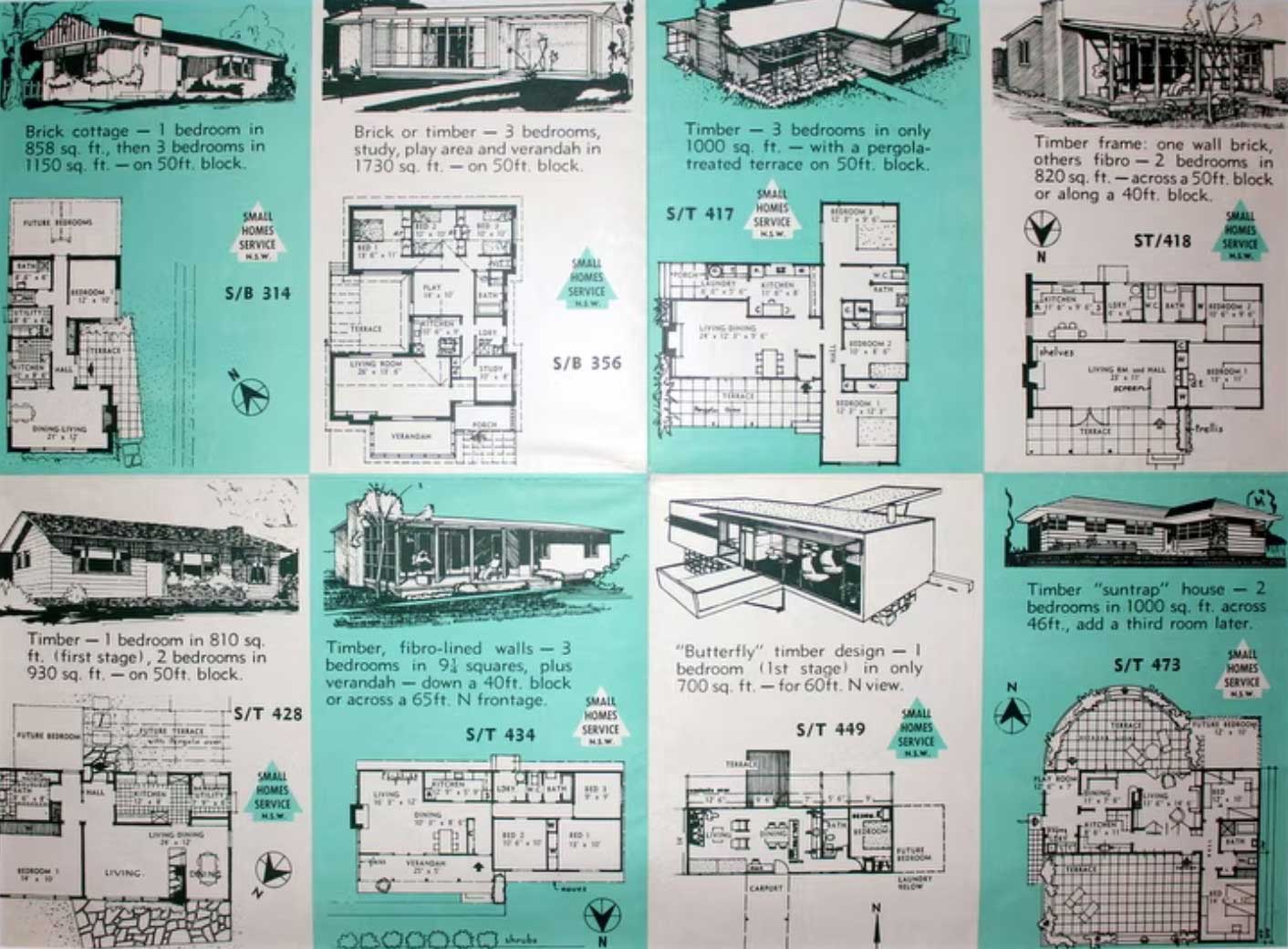Source: National Library of Australia
A Grand Plan
Amid the current housing crisis, where affordability and sustainability are pressing concerns, we can draw inspiration from the innovative approach of the Australian Institute of Architects’ Small Home Service that ran from the 1950’s until the late 70’s. By examining its principles and strategies, we can explore how they could be applied to address the contemporary housing challenges we face today.
This post war period marked an era of rapid urbanisation in Australia, with a rising demand for housing. The Small Home Service, initiated by the Australian Institute of Architects, aimed to address this need by providing affordable and well-designed housing solutions to the general public. Architect-designed small homes were promoted to combat the shortage of affordable housing and empower individuals to realise their dreams of homeownership.
 Source: State Library Victoria
Source: State Library Victoria
Helmed by Robin Boyd a leading Architect of this time and promoted in Victoria by the Age newspaper and magazines like Home Beautiful, the scheme envisioned a housing solution that was affordable, adaptable, and easily constructed. For just 5 pounds you could purchase a home design from a catalogue complete with working drawings and specifications. To ensure some level of exclusivity, each design was limited to the construction of 25 homes in the city, and 25 in the country.
 Source: Home Beautiful Magazine, July 1961
Source: Home Beautiful Magazine, July 1961
Boyd even developed a range of DIY modular homes sold through Myer Stores aimed to provide Australians with the opportunity to build their own high-quality homes with minimal expertise. The concept centred around using prefabricated components that could be easily assembled and customized to suit individual needs, allowing homeowners to have a hand in the construction process.
One of the key aspects of Boyd’s modular homes was their flexibility. The design allowed for easy expansion or modification as the homeowner’s needs changed over time. Whether it was adding an extra bedroom, expanding the living space, or incorporating sustainable features, Boyd’s modular homes were adaptable to evolving lifestyles. This flexibility not only catered to individual needs but also made the homes more sustainable in the long run.
 Source: National Library of Australia
Source: National Library of Australia
The Small Home Service offered catalogues of competition-winning home designs developed by many Architects which emphasised compact yet functional designs that maximised the efficient use of limited space. This approach allowed for the inclusion of essential amenities while minimising costs.
Architects were encouraged to think creatively and experiment with new construction techniques and materials. The focus was on creating aesthetically pleasing homes that catered to the specific needs and aspirations of homeowners.
Even in the 1960s, the Small Home Service recognized the importance of sustainability. Passive design strategies, such as orientation for optimal natural light and ventilation, were incorporated. Additionally, the use of energy-efficient materials and technologies was promoted.
 Source: State Library Victoria
Source: State Library Victoria
In today’s context with skyrocketing property prices and limited affordable housing options, the principles of the Small Home Service are still relevant. By encouraging the development of smaller, well-designed homes, we can offer more affordable alternatives for individuals and families.
Architects are ideally positioned to explore innovative design solutions that optimise the use of space and resources, such as modular construction, micro-housing concepts, and shared living arrangements. This approach would not only increase housing availability but also foster a sense of community.
In our current era of environmental awareness, incorporating sustainable practices is crucial. Drawing inspiration from the Small Home Service, we can prioritise energy-efficient designs, the use of eco-friendly materials, and the integration of renewable energy sources to reduce the environmental impact of housing.
The Australian Institute of Architects’ Small Home Service from the past mid-century offers valuable insights that can be applied to address the current housing crisis. By embracing the principles of efficient space utilisation, design innovation, and sustainability, we can create affordable, well-designed, and environmentally conscious housing solutions for the masses. Building upon the legacy of the Small Home Service, architects, policymakers, and communities can collaborate to shape a brighter future where safe, affordable, and sustainable housing is accessible to all.
You might also be interested in...

The Most Popular Home Configurations in Australia in 2024
Discover 2024’s top Australian home configurations: bedrooms, bathrooms, and parking preferences. Explore how changing lifestyles shape popular house configurations nationwide.

Exploring Contemporary Applications of Brise Soleil
Contemporary applications of Brise Soleil combine functionality, aesthetics, and sustainability, making them a popular choice in various building designs worldwide.










